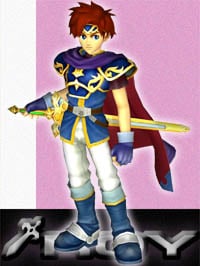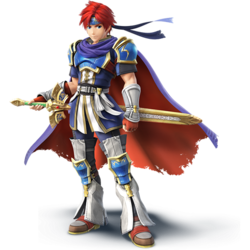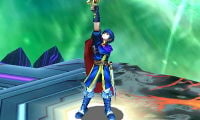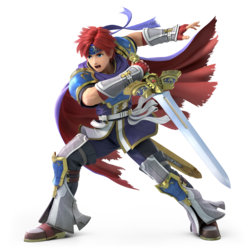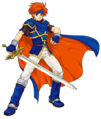Roy: Difference between revisions
No edit summary |
|||
| Line 113: | Line 113: | ||
! Game | ! Game | ||
! Effect | ! Effect | ||
! | ! Fighter(s) | ||
|- | |- | ||
| [[Roy]] | | [[Roy]] | ||
Revision as of 19:37, March 23, 2023
- For fighter info, see Roy (SSBM), Roy (SSB4), and Roy (SSBU). For other characters with the same name, see Roy (disambiguation).
| Roy | |
|---|---|
{{{content1}}}
{{{content2}}}
{{{content3}}} 
Official artwork of Roy from Fire Emblem: The Binding Blade , Fire Emblem Awakening, and Fire Emblem Heroes. | |
| Universe | Fire Emblem |
| Debut | Super Smash Bros. Melee (2001, video game debut) Fire Emblem: The Binding Blade (2002, home series debut) |
| Smash Bros. appearances | Melee Brawl SSB4 Ultimate |
| Most recent non-Smash appearance | Fire Emblem Engage (2023) |
| Console/platform of origin | Nintendo GameCube (technical debut) Game Boy Advance (proper debut) |
| Species | Human |
| Gender | Male |
| Place of origin | Lycia |
| Designed by | Eiji Kaneda |
| English voice actor | Ray Chase (Ultimate) |
| Japanese voice actor | Jun Fukuyama |
| Article on Fire Emblem Wiki | Roy |
Roy (ロイ, Roy) is the protagonist of Fire Emblem: The Binding Blade, the sixth game in the Fire Emblem series. He debuted in Super Smash Bros. Melee as an unlockable character, and returned as a playable character in both Super Smash Bros. 4 and Super Smash Bros. Ultimate after being absent from Super Smash Bros. Brawl.
Origin
Fire Emblem: The Binding Blade was nearing the end of its development during the development of Super Smash Bros. Melee, the first Smash game to include Fire Emblem content. The Binding Blade was originally scheduled to be released prior to Melee itself, although it was delayed into 2002. The inclusion of Roy in Melee—a decision made with no knowledge of release dates—was a successful ploy to Japanese audiences for both Melee and The Binding Blade.
However, since this involved a game franchise never distributed outside of Japan beforehand, Nintendo was wary of keeping the unfamiliar fantasy swordsmen in Melee in its overseas releases. The decision was made to keep them in based on the approval of western gamers and him being "fun",[1] and Marth and Roy's popularity in Melee is generally considered to be a factor in the Fire Emblem franchise gaining international interest from gaming audiences, leading to it receiving regular international releases.
Roy hails from Lycia, one of six nations of the land of Elibe, and is the son of Eliwood, ruler of the Lycian noble house of Pherae. The game begins with Roy called back home from his studies in the province of Ostia in response to the militant nation of Bern launching invasions of Elibe's other realms. As Eliwood has fallen ill, Roy is entrusted with leading Pherae's army alongside the other armies of the Lycian League against Bern and its ruler, Zephiel, who displays a mysterious thirst for the destruction of human rule. Zephiel's errant younger sister, Princess Guinivere, escapes Bern and comes to Roy in defiance of her brother's motives, hoping to negotiating a treaty with Lycian nobility. Roy quickly agrees to her proposal to search for a peaceful means to end Bern's aggression.
The war, and their quest to end it, takes Roy and Guinivere across Elibe. They fight the forces of Bern and opportunistic traitors within other countries, unite other lands behind their cause, and learn of Zephiel's ambition to return Elibe to dragon rule to right what he views as a wrong: The Scouring, an ancient war in which humans drove dragons out of Elibe. To achieve their mission, Guinivere entrusts Roy with the Fire Emblem, an important gemstone in the culture of Bern which Roy uses to unlock the Binding Blade, a powerful weapon from the age of the Scouring once wielded by the forefather of Bern, Hartmut.
Once he acquires the Binding Blade, Roy invades Bern and defeats Zephiel in his own castle, then—in the game's good ending—embarks on a quest to find Zephiel's ally Idunn, a soulless Demon Dragon created by ancient dragons to fight back against humanity, seeking to undo the damage that the dragons did to her. Regardless of the ending the player achieves, the game ends with Roy returning to Pherae and helping rebuild, eventually succeeding his father as its marquess.
Roy is an upstanding and thoughtful fifteen year-old young man with a natural proclivity to help and support others. While he would prefer to avoid bloodshed and works to find a peaceful resolution to the conflict, he maintains a strong resolve to see peace return to Elibe. He is a talented tactician in his own right, and unusually is perceptive and cunning for his age: he is able to trick a traitorous vassal in his group into exposing himself, and he reacts calmly and tactically to surprises and disturbing news.
Roy's childhood friend Lilina describes him as somewhat socially awkward, and he is quite oblivious to the obvious feelings that some of the women in his army develop for him. Roy is similar to Marth with respect to both characterization and gameplay role, and is the only character in The Binding Blade to be of the Lord character class. As the commander of his army, it is necessary for Roy to seize castles and thrones held by enemy armies to complete chapters and progress in his quest, but if he is defeated in battle, the game is over and the player must restart from their last save point.
Intelligent Systems followed up The Binding Blade with a prequel set twenty years prior to Roy's adventures in Elibe: Fire Emblem: The Blazing Blade (originally released outside Japan simply as "Fire Emblem"), the franchise's seventh installment and the first internationally-released one. The game stars Roy's father Eliwood, whose somewhat older resemblance to Roy was meant to appeal to players of Melee; Roy himself appears as a five-year-old child in the game's epilogue. The game's story is laid out with ten introductory chapters starring one of Eliwood's allies, Lyn, meant to introduce players to the Fire Emblem style of tactical play, with the other 20+ chapters containing the main story. Though it is a prequel, The Blazing Blade is structured so that no knowledge of The Binding Blade is required to understand its story.
Although he did not appear in a new game for nine years after The Blazing Blade, Roy started making regular appearances with Marth and Ike in various Fire Emblem crossovers and spinoffs in 2012 when he appeared as a bonus SpotPass and DLC Einherjar in Fire Emblem Awakening. In 2017, Roy's design was updated to reflect his modernized appearance in Super Smash Bros. 4, combining elements from The Binding Blade and Awakening: Fire Emblem Heroes featured him as a summonable hero (with his first variant more closely resembling his Super Smash Bros. 4 design instead of his original design from The Binding Blade), debuting Ray Chase as his English voice actor, and Fire Emblem Echoes: Shadows of Valentia allows players to summon an illusory phantom of Roy using his Super Smash Bros. amiibo. Roy has also made frequent appearances in the Fire Emblem Cipher trading card game since 2016. Most recently, Fire Emblem Engage features Roy as one of the game's numerous Emblems, ethereal clones of protagonists from various other Fire Emblem games who dwell within special rings.
In Super Smash Bros. Melee
As a playable character
Roy makes his Super Smash Bros. series debut (and by extension, his debut in any game) as an unlockable character in Super Smash Bros. Melee. He can be unlocked in two ways: beating either Classic Mode or Adventure Mode as Marth on any difficulty, or playing 900 Versus Mode matches. Due to the Fire Emblem series being exclusive to Japan at the time, Roy is voiced by Jun Fukuyama in both the Japanese and Western releases.[1]
According to Super Smash Bros. series creator Masahiro Sakurai, he originally wanted Marth as a playable character in SSB because of his desire for representation of both the Fire Emblem series and the swordsman archetype.[1] Due to not making this deadline, Sakurai decided that Melee would include Marth and the then-upcoming Fire Emblem protagonist Roy.[1]
In regard to Roy, Sakurai explained that his inclusion as Marth's clone was because Roy's game, Fire Emblem: The Binding Blade, was nearing the end of its development during the development of Melee.[1] Although The Binding Blade was originally scheduled to be released prior to Melee, its release was delayed to 2002, thus resulting in Roy's debut occurring outside of his home series.[1][2]
Although Sakurai consistently pushed to keep Marth within both the Japanese and Western releases of Melee, internal discussions and disputes lead to him and Nintendo of America holding meetings to discuss Roy's status within the Western release.[1] Despite Sakurai being willing to remove Roy from the Western release, Nintendo of America decided to retain both characters; in regard to Roy, it was because they said, according to Sakurai, "He'll be fun, so let's leave him as is."[1] Sakurai also said the inclusion of Marth and Roy lead to a "reciprocal relationship" in that Melee benefited from the fanbase's perception of them as fun characters, while the Fire Emblem series in turn garnered a much larger audience thanks to their inclusion.[1]
Roy wields the Binding Blade (referred to as the Sword of Seals in Melee), which is used for almost every one of his moves, aside from his grabs and throws. In contrast to Marth's Falchion, the Binding Blade is most powerful near its hilt instead of at its tip.[1][2] True to its depiction in The Binding Blade, it also has a multitude of flame-based attacks. Roy's neutral special move, Flare Blade, is a chargeable sword strike akin to Marth's Shield Breaker. However, it can be charged up to 5 seconds, after which it will unleash an explosion powerful enough to one-hit KO virtually any opponent, although Roy receives 10% recoil damage as a side effect.
Roy's side special move, Double-Edge Dance, functions like Marth's Dancing Blade in that it is a series of up to four sword slashes determined by the number of times the special button is pressed and which direction the control stick is pressed during each swipe. Roy's up special move, Blazer, deals more damage, hits multiple times and emits flames compared to Marth's Dolphin Slash, yet it is also slower.[2] Lastly, Roy's down special move, Counter,[1] functions similarly to Marth's: it has a larger damage multiplier (1.5×) and is thus capable of easily KOing opponents who use a sufficiently strong attack, yet it has more start-up, a shorter duration,[2] and a sourspot.
Due to being a clone of Marth, Roy's mobility and attack style are largely similar, yet their specifications are different. Roy has a relatively fast dashing speed, a fast and long dash-dance, and a very fast falling speed;[2] altogether, these make his short hop aerials almost as proficient as Marth's. Double-Edge Dance is very useful in battle, thanks to its various combo routes. Roy's forward smash and Flare Blade are powerful KOing options and even decent at edge-guarding, while his grab range is deceptively long like Marth's. However, Roy is held back by a slew of flaws. Although he shares Marth's weaknesses of an unimpressive recovery and lack of a projectile, Marth overwhelmingly outclasses him because of Roy's glaring susceptibility to combos and juggles, overall low damage output, and the Binding Blade's notoriously ineffective hitboxes.
Roy and Marth were a primary subject of the "tier wars" at GameFAQs that lasted between 2003 and 2004, determining which among these two very similar fighters was the better character, while Marth ultimately won by a very large margin. This has been reflected in his ranking of 21st out of 26 on the current tier list, which places him in the F tier and renders him a low tier character. Despite being universally considered an inferior clone of Marth, Roy developed a loyal fanbase nonetheless.
Trophies
In line with the other playable characters, Roy as a playable character is featured on three trophies: a normal trophy acquired by beating the Classic Mode with Roy on any difficulty, and Smash Red and Smash Blue trophies are won by beating the Adventure and All-Star Modes, respectively.
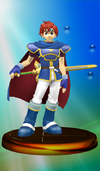
- Roy
- The son of the lord of Pharae Principality, Roy was studying in Ostia when the Kingdom of Bern invaded League of Lycia. His father fell ill at this time, so Roy assumed leadership of Pharae's armies. After his fateful meeting with the Princess Guinevere, his destiny became inextricably linked with the fate of the entire continent.
- Fire Emblem (Japan Only)
- Future Release

- Roy SMASH
- While Roy's moves are well balanced, he's a little on the slow side, and doesn't excel at midair combat. His blade, the Sword of Seals, gives him excellent reach, and makes his Double-Edge Dance slightly different than Marth's Dancing Blade. When it's fully charged, Roy's destructive Flare Blade delivers an instant KO.
- B: Flare Blade
- Smash B: Double-Edge Dance

- Roy SMASH
- Roy's blade is different than Marth's; he does the most damage hitting with the center of his sword. So, a fearless advance into the arms of his foe is Roy's best bet. Blazer is a bit slower than Marth's Dolphin Slash, but it's still a mighty attack that sets anyone it strikes aflame. Roy's attack after using Counter differs slightly from Marth's.
- Up & B: Blazer
- Down & B: Counter
In Super Smash Bros. Brawl
Roy is one of the five playable characters in Melee who did not return as a playable character in Brawl. His only appearance in the game is as a sticker of his official artwork from Fire Emblem: The Binding Blade. Roy is also referenced in the title of "Winning Road - Roy's Hope", a theme from his game that can be played on Castle Siege.
Unfinished data
While Roy does not appear as a playable character in Brawl, data of what appears to be the character has been uncovered through hacking as ef_roy.pac., alongside Dr. Mario and Mewtwo. The exact reason why the data is included is unknown, though it is commonly believed that Roy was planned to be included as a playable character before being cut for unknown reasons. Of particular note is that the data for Roy includes his own unused fanfare, as "snd_bgm_Z39_FROY", further indicating that he was intended to be playable in Brawl.
Sticker
| Name | Game | Effect | Fighter(s) |
|---|---|---|---|
| Roy | Fire Emblem: The Binding Blade |
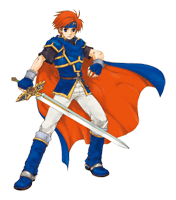 Roy (Fire Emblem: The Binding Blade) |
In Super Smash Bros. 4
As a playable character
Although Roy did not return as a playable character in the base version of Super Smash Bros. 4, the rearranged song "Winning Road - Roy's Hope" from The Binding Blade returns from Brawl for Super Smash Bros. for Wii U.
Due to data mining of update 1.0.6, Roy's presence as a playable character within the game's files was leaked in mid-April 2015.[3] He was then made available as downloadable content on June 14th, 2015 alongside Lucas and Ryu.[4] Jun Fukuyama reprises his role as Roy's voice actor via new lines that mimic his lines in Melee.[1]
In the transition to SSB4, Roy underwent a considerable overhaul, both aesthetically and mechanically. Due to Masahiro Sakurai's desire to modernize Roy's design, his attire became a combination of his design from The Binding Blade and his mercenary design from Fire Emblem Awakening. In reference to SSB4's co-lead developer Bandai Namco, Sakurai jokingly referred to this updated design as having "a sort of Tales-ish appearance."[5]
Due to acknowledging Marth's superiority to Roy in Melee, Sakurai sought to modify Roy's attributes and moveset.[5] To this end, several of Roy's animations now consist of him swinging the Binding Blade in a reverse grip,[1] while the Binding Blade itself is drastically stronger.[1][5] In addition, Roy's already excellent dashing speed is even faster, and unlike in Melee, he now boasts an extremely fast air speed. Due to these changes, Roy was effectively de-cloned into a semi-clone of Marth.
Roy also received his own Final Smash; in his case, it is Critical Hit.[5] Unlike Marth and Lucina's versions, however, Roy performs it similarly to his critical hit animation in The Binding Blade: he remains stationary as he swings the Binding Blade in a circular motion, then performs a downward slash to generate a powerful explosion.[5]
Thanks to his increased overall damage output, modified frame data, and his updated moves being much stronger than his previous ones, Roy is much more capable at dealing damage and KOing. Roy was also buffed indirectly via gameplay changes: the changes to hitstun canceling grant his modified down throw respectable combo potential, the changes to shield mechanics significantly improve his sweetspots' safety on shield, and rage supplements his already impressive power.
However, the Binding Blade's inverse tipper mechanic still requires Roy to get dangerously close to opponents to strike with the sword's sweetspot, which is counter-intuitive for a swordsman. Aside from this, Roy also received direct and indirect nerfs: his reworked animations decreased the ranges on some moves, while the weakening of dash-dancing and the removal of both wavedashing and L-canceling weakened his approach.
Due to achieving decent results in spite of below-average representation, Roy is ranked 42nd out of 55 on the current tier list. This places him in the E tier, and renders him a mid tier character.
As an alternate costume
Marth has a new alternate costume based on Roy's design in The Binding Blade.
Trophies
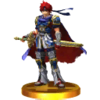
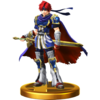
- Roy
- Roy, the main character of Fire Emblem: The Binding Blade, returns for the first time since Melee! In The Binding Blade, Roy led the troops of Pherae into battle in his ailing father's stead, and now he brings his speed and talent for short-range combat into this game. His sword, the Sword of Seals, is uniquely powerful at the base of the blade.
: Fire Emblem: The Binding Blade (2002 (JP))
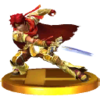
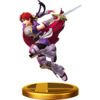
- Roy (Alt.)
- Flare Blade creates an explosion in front of Roy that can be charged by holding down the button. Take care, though, because at the highest levels of charge, Roy himself will catch fire and take damage! His side special, Double-Edge Dance, changes for each strike after the first depending on whether you hold up or down while attacking.
: Fire Emblem: The Binding Blade (2002 (JP))
In Super Smash Bros. Ultimate
As a playable character
Roy returns as a playable character in Super Smash Bros. Ultimate.[6] Like his fellow Fire Emblem fighter Marth, Roy is now fully voiced in English outside of the Japanese version, with Ray Chase reprising his role from Fire Emblem Heroes.
Presumably due to his mid tier status in Super Smash Bros. 4, Roy has been significantly buffed in the transition to Ultimate. He benefits immensely from universal changes, arguably more so than any other fighter: the standardization of 3 frame jumpsquats and gerenal reduction of landing lag greatly improve the utility of his powerful aerial attacks, while the return of dash dancing and expanded utility of dash canceling does much the same for his strong grounded attacks. The Binding Blade's hilt sweetspot is also much larger, his attacks' already high knockback has increased even further, and his movement and frame data are both faster. Overall, these changes collectively improved Roy's tournament representation and results to a significant degree, with most players agreeing that he has become a high tier fighter.
Spirit
Names in other languages
| Language | Name |
|---|---|
| ロイ, Roy | |
| Roy | |
| Roy | |
| Roy | |
| Roy | |
| Roy | |
| 罗伊, Roy | |
| 羅伊, Roy | |
| 로이, Roy | |
| Roy | |
| Рой | |
| Roy |
Trivia
- Roy's official artwork pose for both Melee and SSB4 resembles his neutral pose as a Great Lord when wielding the Binding Blade in Fire Emblem: The Binding Blade.
- Due to Melee launching before Fire Emblem: The Binding Blade, Roy is the only playable character whose debut occurred in the Super Smash Bros. series instead of his own home series.
- However, while Mr. Game & Watch was seen in several games prior to Melee, he was not given a distinctive identity prior to Smash.
- Roy is the only character whose moveset is based on Marth's that does not wield a variation of the Falchion, and the only one to not have any connection to Marth in the Fire Emblem games.
- Roy's crowd cheer, "Roy's our boy!", has become popular among Super Smash Bros. fans, and is often used as a meme. The cheer's popularity was even touched upon in Fire Emblem Heroes, in which the Brave Lion variant of Roy says it as one of his voice clips.[7]
- Prior to Ultimate, Roy, Toon Link and Young Link were the only swordsmen in the Super Smash Bros. series whose swords consistently produced a punch/kick sound effect instead of a slashing sound effect for the majority of their moves.
- Roy is the very first playable character in the Super Smash Bros. series to have debuted in the 21st century.
- Roy and Lucas are the only two playable characters to never have their canon game of origin released outside of Japan.
- Roy's English voice actor, Ray Chase, has said in interviews that Roy was one of his mains (the other being Dr. Mario) in previous Super Smash Bros. games before he was casted in the role.[8]
- Roy is currently the only fighter available as DLC at any point to lack a projectile attack.
- As of SSB4, Roy shares his name with Roy Koopa, another playable character, making it the only repeated name in the Super Smash Bros. roster. However, Roy Koopa is an alternate character that shares a slot with Bowser Jr. instead of being a full-fledged character.
- Owing to this, both of them are seen together in official screenshots several times, such as the Congratulations screen of Roy's Classic Mode route in Ultimate.
- Roy, Pit, and Palutena are the only characters who received a modernized redesign in the Super Smash Bros. series that would be later featured in their respective home series.
References
- ^ a b c d e f g h i j k l m n Sakurai Interview: Fire Emblem 25th Anniversary - Source Gaming
- ^ a b c d e News Flash! Smash Bros. Dojo: Roy - Source Gaming
- ^ All About Ryu and Roy's Files - Source Gaming
- ^ Super Smash Bros. for Nintendo 3DS / Wii U - New Content Approaching 6.14.15
- ^ a b c d e Nintendo Dream Interview with Sakurai: Part 2 - Source Gaming
- ^ Super Smash Bros. Ultimate - E3 2018 - Nintendo Switch
- ^ Roy's Our Boy (2017) Fire Emblem Heroes
- ^ Lee, O. "Interview with Ray Chase, FINAL FANTASY’s Noctis and FIRE EMBLEM’s Roy and Alfonse". AsianCrush. Published December 5th 2018. Retrieved December 5th, 2018
|
| |
|---|---|
| Fighters | Marth (SSBM · SSBB · SSB4 · SSBU) · Roy (SSBM · SSB4 · SSBU) · Ike (SSBB · SSB4 · SSBU) · Lucina (SSB4 · SSBU) · Robin (SSB4 · SSBU) · Corrin (SSB4 · SSBU) · Chrom (SSBU) · Byleth (SSBU) |
| Assist Trophies | Lyn · Black Knight · Tiki |
| Stages | Castle Siege · Arena Ferox · Coliseum · Garreg Mach Monastery |
| Item | Killing Edge |
| Other | Sothis |
| Trophies, Stickers and Spirits | Trophies (SSBM · SSBB · SSB4) · Stickers · Spirits |
| Music | Brawl · SSB4 · Ultimate |
| Masterpieces | Fire Emblem: Shadow Dragon and the Blade of Light · Fire Emblem: Mystery of the Emblem |
